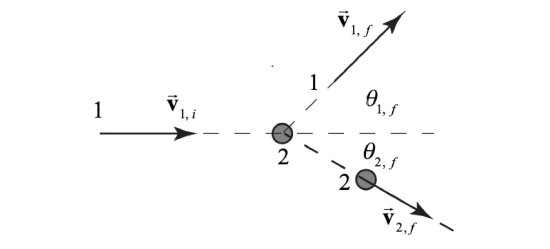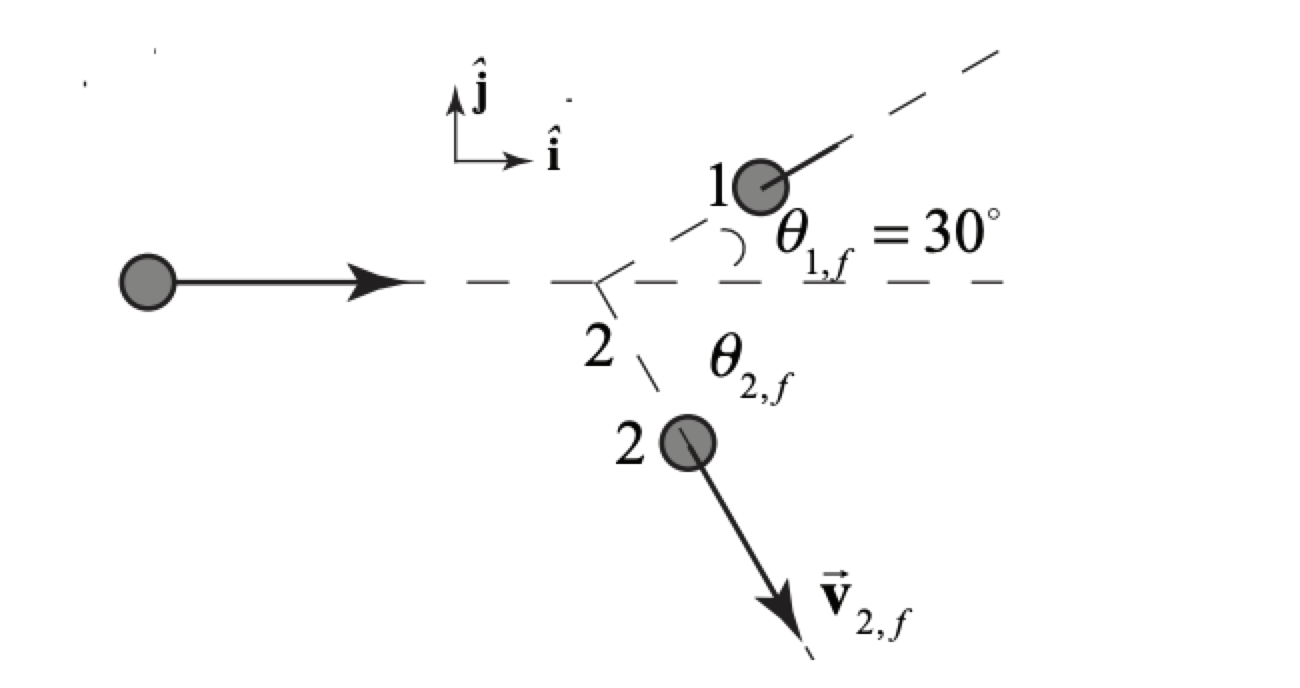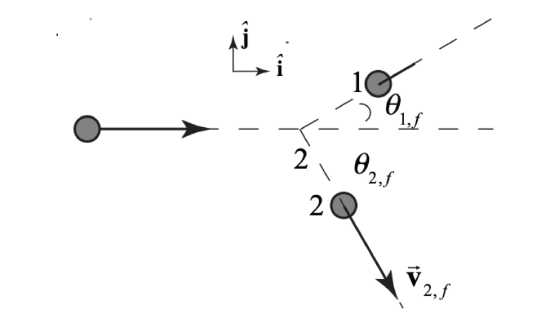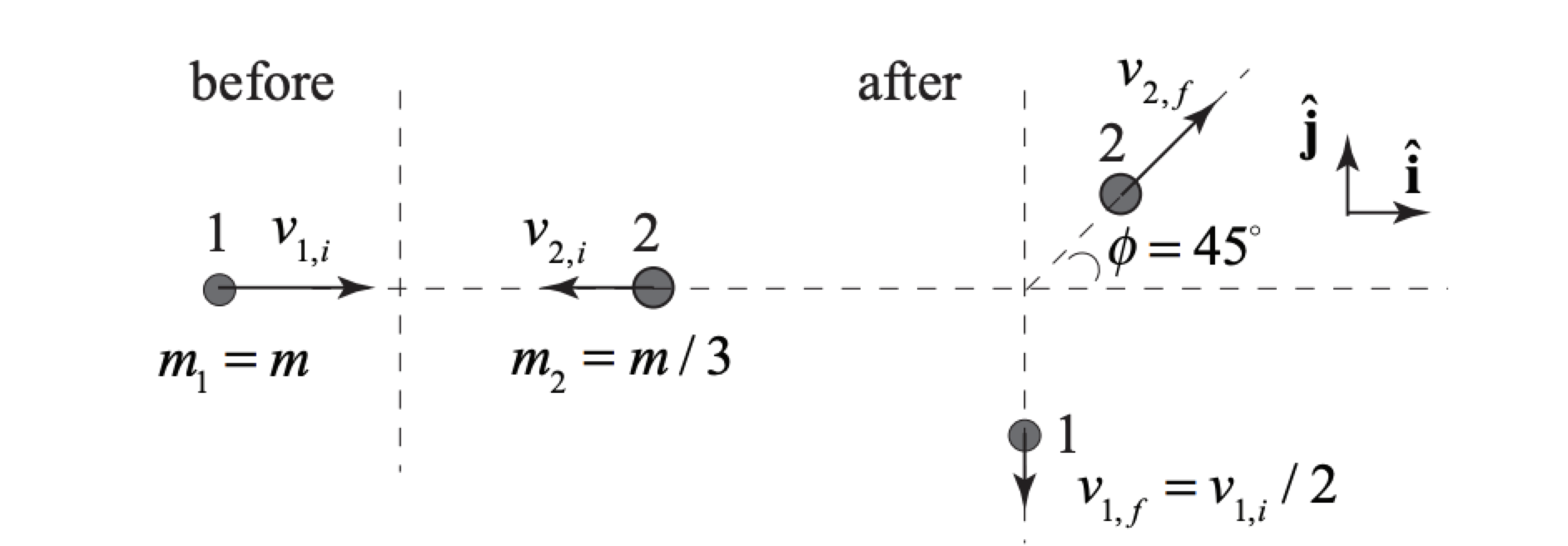15.6: Two Dimensional Elastic Collisions
( \newcommand{\kernel}{\mathrm{null}\,}\)
Two-dimensional Elastic Collision in Laboratory Reference Frame
Consider the elastic collision between two particles in which we neglect any external forces on the system consisting of the two particles. Particle 1 of mass m1 is initially moving with velocity →V1,i and collides elastically with a particle 2 of mass that is m2 initially at rest. We shall refer to the reference frame in which one particle is at rest, ‘the target’, as the laboratory reference frame. After the collision particle 1 moves with velocity →V1,f, and particle 2 moves with velocity →V2,f, (Figure 15.9). The angles θ1,f and θ2,f that the particles make with the positive forward direction of particle 1 are called the laboratory scattering angles.

Generally the initial velocity →v1,i of particle 1 is known and we would like to determine the final velocities →V1,f and →V2,f, which requires finding the magnitudes and directions of each of these vectors, v1,f,v2,f,θ1,f and θ2,f These quantities are related by the two equations describing the constancy of momentum, and the one equation describing constancy of the kinetic energy. Therefore there is one degree of freedom that we must specify in order to determine the outcome of the collision. In what follows we shall express our results for v1,f,v2,f, and θ2,f in terms of v1,i and θ1,f.
The components of the total momentum →psysi=m1→v1,i+m2→v2,i psysx,i=m1v1,ipsysy,i=0 The components of the momentum →psysf=m1→v1,f+m2→v2,f in the final state are given by psysx,f=m1v1,fcosθ1,f+m2v2,fcosθ2,fpsysy,f=m1v1,fsinθ1,f−m2v2,fsinθ2,f There are no any external forces acting on the system, so each component of the total momentum remains constant during the collision, psssx,i=pssx,f pssy,i=psysy,f Equations (15.6.3) and (15.6.4) become m1v1,i=m1v1,fcosθ1,f+m2v2,fcosθ2,f, 0=m1v1,fsinθ1,f−m2v2,fsinθ2,f. The collision is elastic and therefore the system kinetic energy of is constant Ksysi=Ksysf Using the given information, Equation (15.6.7) becomes 12m1v21,i=12m1v21,f+12m2v22,f Rewrite the expressions in Equations (15.6.5) and (15.6.6) as m2v2,fcosθ2,f=m1(v1,i−v1,fcosθ1,f) m2v2,fsinθ2,f=m1v1,fsinθ1,f Square each of the expressions in Equations (15.6.9) and (15.6.10), add them together and use the identity cos2θ+sin2θ=1 yielding v22,f=m21m22(v21,i−2v1,iv1,fcosθ1,f+v21,f) Substituting Equation (15.6.11) into Equation (15.6.8) yields 12m1,i=12m1v21,f+12m21m2(v21,i−2v1,iv1,fcosθ1,f+v21,f) Equation (15.6.12) simplifies to 0=(1+m1m2)v21,f−m1m22v1,iv1,fcosθ1,f−(1−m1m2)v21,i Let α=m1/m2 then Equation (15.6.13) can be written as 0=(1+α)v21,f−2αv1,iv1,fcosθ1,f−(1−α)v21,i The solution to this quadratic equation is given by v1,f=αv1,icosθ1,f±(α2v21,icos2θ1,f+(1−α)v21,i)1/2(1+α) Divide the expressions in Equation (15.6.9), yielding v2,fsinθ2,fv2,fcosθ2,f=v1,fsinθ1,fv1,i−v1,fcosθ1,f Equation (15.6.16) simplifies to tanθ2,f=v1,fsinθ1,fv1,i−v1,fcosθ1,f
The relationship between the scattering angles in Equation (15.6.17) is independent of the masses of the colliding particles. Thus the scattering angle for particle 2 is θ2,f=tan−1(v1,fsinθ1,fv1,i−v1,fcosθ1,f) We can now use Equation (15.6.10) to find an expression for the final velocity of particle 1 v2,f=v1,fsinθ1,fαsinθ2,f
Example 15.5 Elastic Two-dimensional collision of identical particles

Object 1 with mass is initially moving with a speed = 3.0m⋅s−1 and collides elastically with object 2 that has the same mass, m2=m1, and is initially at rest. After the collision, object 1 moves with an unknown speed v1,f at an angle θ1,f, with respect to its initial direction of motion and object 2 moves with an unknown speed v2,f, at an unknown angle θ2,f, f (as shown in the Figure 15.10). Find the final speeds of each of the objects and the angle θ2,f.
Solution
Because the masses are equal, α=1. We are given that v1,i=3.0m⋅s−1. We are given that v1,i=3.0m⋅s−1 and θ1,f=30∘. Hence Equation (15.5.14) reduces to v1,f=v1,icosθ1,f=(3.0m⋅s−1)cos30∘=2.6m⋅s−1
Substituting Equation (15.6.20) in Equation (15.6.17) yields θ2,f=tan−1(v1,fsinθ1,fv1,i−v1,fcosθ1,f)θ2,f=tan−1((2.6m⋅s−1)sin(30∘)3.0m⋅s−1−(2.6m⋅s−1)cos(30∘))=60∘ The above results for v1,f and θ2,f may be substituted into either of the expressions in Equation (15.6.9), or Equation (15.6.11), to find v2,f=1.5m⋅s−1. Equation (15.6.11) also has the solution v2,f=0, which would correspond to the incident particle missing the target completely.
Before going on, the fact that θ1,f+θ2,f=90∘ that is, the objects move away from the collision point at right angles, is not a coincidence. A vector derivation is presented in Example 15.6. We can see this result algebraically from the above result. Substituting Equation (15.6.20) v1,f=v1,icosθ1,f in Equation (15.6.17) yields tanθ2,f=cosθ1,fsinθ1,f1−cosθ21,f=cotθ1,f=tan(90∘−θ1,f) showing that θ1,f+θ2,f=90∘, the angles θ1,f and θ2,f are complements.
Example 15.6 Two-dimensional elastic collision between particles of equal mass
Show that the equal mass particles emerge from a two-dimensional elastic collision at right angles by making explicit use of the fact that momentum is a vector quantity.

Solution
Choose a reference frame in which particle 2 is initially at rest (Figure 15.11). There are no external forces acting on the two objects during the collision (the collision forces are all internal), therefore momentum is constant →psysi=→psysf which becomes m1→v1,i=m1→v1,f+m1→v2,f Equation (15.6.24) simplifies to →v1,i=→v1,f+→v2,f Recall the vector identity that the square of the speed is given by the dot product →v⋅→v=v2. With this identity in mind, we take the dot product of each side of Equation (15.6.25) with itself, →v1,i⋅→v1,i=(→v1,f+→v2,f)⋅(→v1,f+→v2,f)=→v1,f⋅→v1,f+2→v1,f⋅→v2,f+→v2,f⋅→v2,f This becomes v21,i=v21,f+2→v1,f⋅→v2,f+v22,f Recall that kinetic energy is the same before and after an elastic collision, and the masses of the two objects are equal, so constancy of energy, (Equation (15.4.2)) simplifies to v21,i=v21,f+v22,f Comparing Equation (15.6.27) to Equation (15.6.28), we see that →v1,f⋅→v2,f=0 The dot product of two nonzero vectors is zero when the two vectors are at right angles to each other justifying our claim that the collision particles emerge at right angles to each other.
Example 15.7 Two-dimensional collision between particles of unequal mass
Particle 1 of mass m1, initially moving in the positive x-direction (to the right in the figure below) with speed v1,i collides with particle 2 of mass m2=m1/3 which is initially moving in the opposite direction (Figure 15.12) with an unknown speed v2,i. Assume that the total external force acting on the particles is zero. Do not assume the collision is elastic. After the collision, particle 1 moves with speed v1,f=v1,i/2 in the negative y-direction. After the collision, particle 2 moves with an unknown speed v2,f at an angle θ2,f=45∘ with respect to the positive x-direction. (i) Determine the initial speed v2i of particle 2 and the final speed v2,f of particle 2 in terms of V1,i. (ii) Is the collision elastic?

Solution
We choose as our system the two particles. We are given that v1,f=v1,i/2. We apply the two momentum conditions, m1v1,i−(m1/3)v2,i=(m1/3)v2,f(√2/2) 0=m1v1,f−(m1/3)v2,f(√2/2) Solve Equation (15.5.31) for v2,f: v2,f=3√2v1,f=3√22v1,i Substitute Equation (15.6.32) into Equation (15.6.30) and solve for v2,i v2,i=(3/2)v1,i The initial kinetic energy is then Ki=12m1v21,i+12(m1/3)v22,i=78m1v21,i The final kinetic energy is Kf=12m1v21,f+12m2v22,f=18m1v21,i+34m1v21,i=78m1v21,i Comparing our results, we see that kinetic energy is constant so the collision is elastic.


